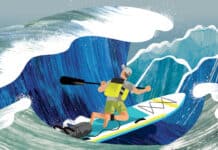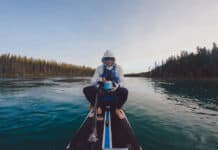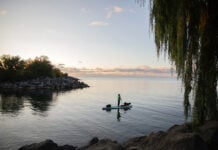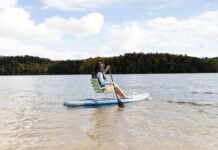Within a couple of hours, the wind picks up and shifts to my right side. The waves, which have nearly all of Lake Ontario’s 200-mile fetch to develop, grow to three and then four and then five feet. Like the apocryphal frog that gets boiled alive, I don’t notice the gradual increases and am ensnared in a tempestuous cauldron.
Humbled on the Great Lakes
Staying far enough from shore to avoid getting slammed into the rocks by breaking waves, yet close enough to remind myself I’m not in the middle of an ocean, I paddle hard on my left side. For the first time since leaving home 1,000 miles ago, I drop to my knees frequently for extra stability. And then, also for the first time since leaving home, even with my center of gravity low, a sneaky steep wave pitches me sideways off the SUP.
I hoist myself back onto the board, relieved I kept my head above the surface and my sunglasses are still atop my hat, relieved it’s early August when Lake Ontario’s often-frigid water temperature climbs above 70°F (21°C), and relieved there’s nobody nearby to witness my chagrin.
Then, another wave sends me tumbling right back into the drink. Only this time, the paddleboard flips over upside down—a possibility I had not once considered with all the weight on its deck.

Bobbing beside my overturned SUP amid the swells, I take stock of the situation. I’m leashed to the board and wearing my PFD and was mindful enough before setting out to clip my dry bags to the elastic tie-down straps with carabiners, so there’s no risk of anything getting lost, present company included. Worst-case scenario, I wash up on shore somewhere, maybe with a few bumps and bruises.
I swim to the SUP, put my hands beneath the near side and push skyward—a maneuver I have only attempted on an unburdened surfboard, but one that proves mercifully easy. The board is right side up, and it’s a snap to shove my bags back into place. Had it been more challenging to reconstitute my kit, I would probably have turned toward land and called it a day. The likelihood of capsizing again is high. But I don’t think there’s any real danger—yet—and I am determined to keep going.
Back up on my feet, I have to focus on each wave as it crests, digging in with my paddle and keeping my core coiled low to remain upright and keep the SUP’s nose pointed in the right direction. I don’t know whether my legs are shaking because I’m frazzled or because I’m pooped or because I’m scared. These are the roughest waters I’ve ever paddled, the redline of my abilities, and I don’t know what might happen next.
It’s too undulant to eat or drink while paddling, my usual procedure on a long day. But luckily, earlier I had spied two places for pit stops on the mostly rocky, privately owned shoreline: a picnic area in a protected inlet and a yacht club behind a breakwater. By late afternoon, after nearly eight hours of left-side paddling and another three or four accidental plunges, I’ve made nearly 25 miles and am alongside a sprawling park on the sandbar. A short canal halfway up the sandbar leads to my goal: the sheltered water of a marina a few minutes from my friend Alan’s house.
Deciding to rest and refuel and give my faltering nerves a break, I turn left and aim for the beach. It’s a holiday weekend, and though overcast and very windy, the sand is packed with families admiring the crashing waves. Shuffling toward the front of the SUP, I catch a swell as it peaks and rocket down the face, enjoying the ride… and then wipe out near the shore as the board flips over.
Once unclipped, I drag my dry bags from the surf so they don’t get washed away. I look out at the waves pounding the beach—rather than at all the people looking at me—and see a police boat hovering just offshore.
Realizing I can’t get back onto the lake—it’d be impossible to reload my board in the shallows, let alone get past the breakers—I begin to shuttle my gear away from the water. When I finally muster everything beside a bench, I’m trembling with exhaustion and adrenaline and a small, nascent taste of trauma.
That’s when the police officer approaches.
“Do you know that boat is out there because of you?” he asks. “People called about you. They saw you fall in a couple of times.”
I explain falling in wasn’t a big deal but concede conditions are indeed dodgy.
“Should you be out there today?” he asks.
“I’m not sure.”
“What’s the plan now?”
“Call a friend.”
“Good idea.”
My decision to head to the beach nags at me for the rest of the evening. I could have continued onward to the channel. I could have reached the bay behind the sandbar. Yet it had been the toughest paddle of my life, more difficult than any session on the Pacific or Atlantic; my body and brain needed a break.
If I hadn’t stopped, something bad could have happened. Granted, I wasn’t in a remote wilderness. The people who had phoned the police were likely among the hundreds I saw barbecuing and lounging outside gorgeous lakefront homes. There were eyes on me all day, and even a rescue boat nearby. Still, was I putting them at risk needlessly? Should I have been out there at all?
My wise friend Alan suggests, after he and his wife Suzanna fed me dinner, that it was a good thing I had been pummeled. Yet another reminder we’re not really in control. Which is one of the reasons paddlers and other outdoorsy types do all sorts of dangerous things for no apparent reason.
We want to be humbled and awed and remember the universe doesn’t care about what we want. My two-and-a-half-month journey into the densely populated heart of a continent isn’t particularly dicey. But it scratches the itch for adventure. And it shows me that the water, amid all of the danger and destruction that it can unleash, is also still a place where people watch out for one another.
Even for hapless knuckleheads like me.
Dan Rubinstein paddled 1,200 miles across Ontario, Quebec and New York, exploring the restorative power of water. This excerpt is from his new book, Water Borne: A 1,200-Mile Paddleboarding Pilgrimage, released in June 2025 by ECW Press.
Feature illustration: Karolina Ficek


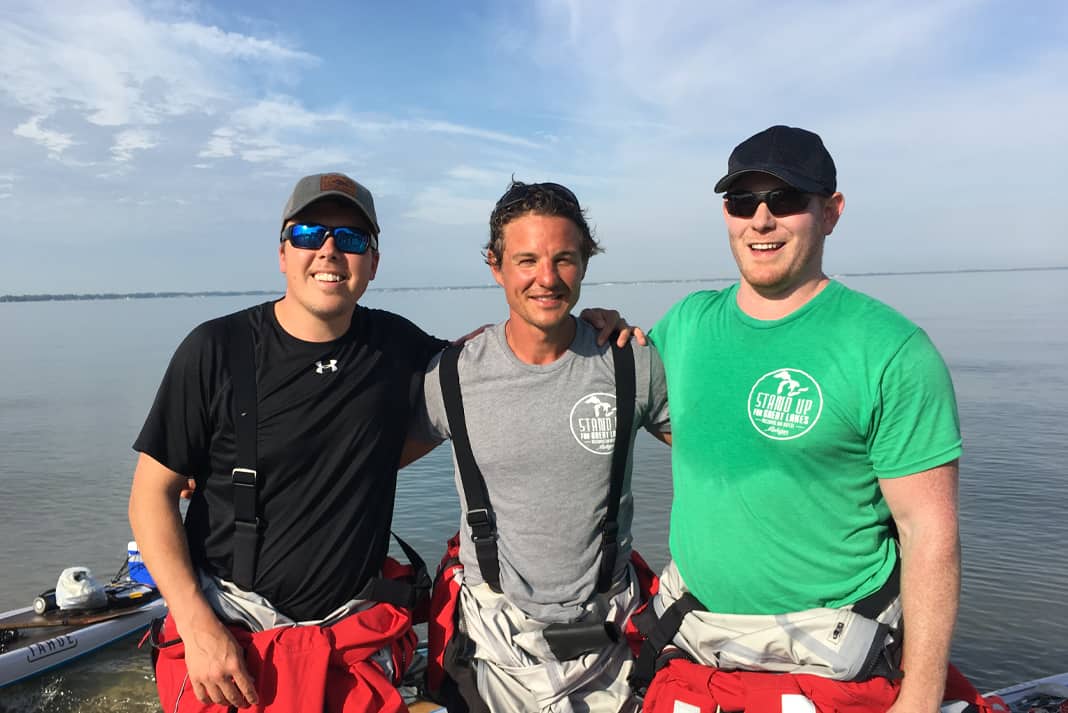
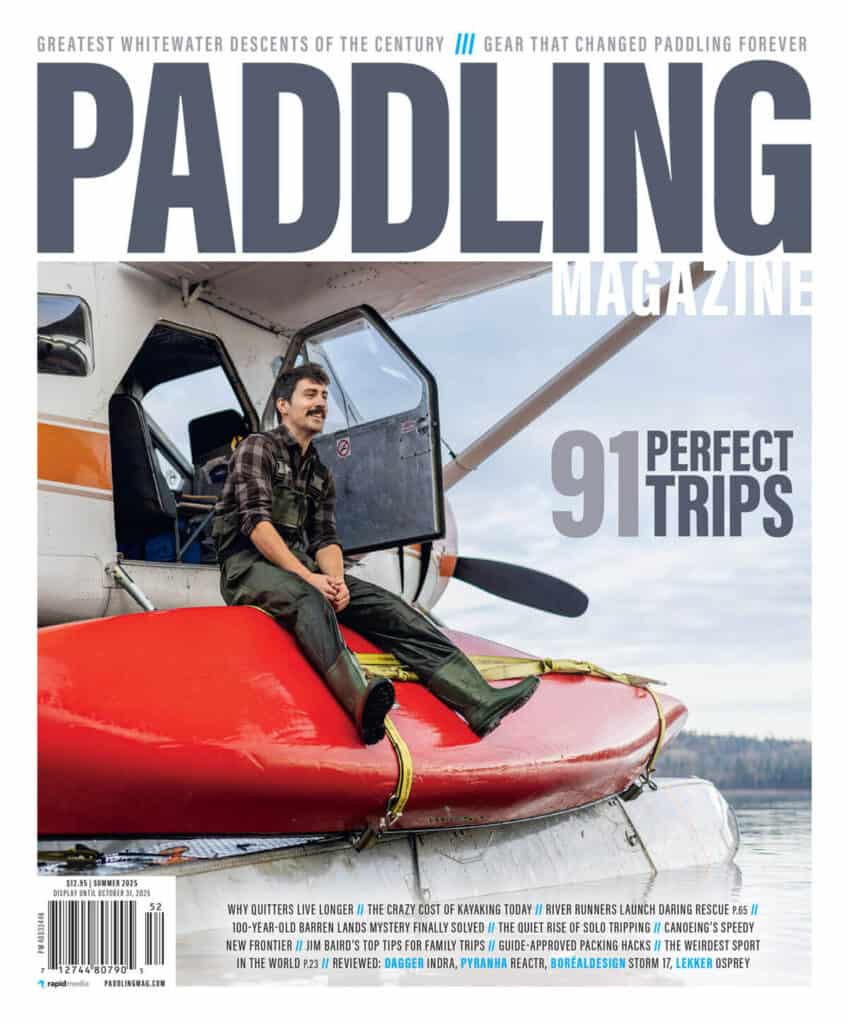 This article was published in Issue 74 of Paddling Magazine.
This article was published in Issue 74 of Paddling Magazine. 